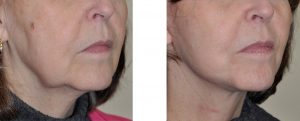A facelift is a well recognized plastic surgery procedure. Despite the recognition of its name, it is still a largely misunderstood operation. I have found very few patients who actually know what a true facelift is or how it is done. The name implies that it is a lifting procedure of the entire face, from the forehead down to the neck. In reality, it is a lifting procedure of the lower third of the face only, an isolated jowl-neck lift. The name of the operation would be more accurate if it was called a necklift rather than a facelift. Further contributing to this confusion is that a facelift is very frequently combined with other facial rejuvenating procedures, such as blepharoplasty and browlifts. This lends to the impression that a complete facial overall is what a facelift is.
As a facelift improves two adjoining lower facial areas, the jowls and the neck, the operation has been subdivided into two main types. A limited facelift affects the jowls only and has become known by many branding names such as Lifestyle Lift and Quicklift. By keeping the incision limited to just the front of the ear, any upward pull of mobilized skin will lift up and smooth out the jowls. A full facelift, however, affects the jowls and the neck. By adding an incision along the back of the ear as well as the front of the ear, neck skin can be lift up as well as that of the jowls.
The skin lifting effect between a limited and a full facelift is determined by the length and location of the incisions. If you stay only on the front side of the ear, only a half result or jowl lift will be obtained. By going up along the back crease of the ear and tailing off into the occipital scalp, freed up neck skin can be moved up behind the ear and removed. (aka full facelift)
But extending the incision on the back of the ear is not needed in some patients and can even be aesthetically undesireable in others. While some patients need some neck improvement that a limited facelift can not do, they may not need as much neck lifting as the typical extended incision on the back of the ear creates. In most men and in women that wear very short hair styles, an extended incision on the back of the ear can be visible. These circumstances have created a facelift that is between a limited and that of a full facelift, what I call a ¾ facelift or a jawline facelift.

The jawline facelift does not replace a full facelift or the indications for it. It is literally a procedure for those aging face patients who have some loose neck skin that is beyond what a limited facelift can treat but not enough that merits a full facelift.
Facelift surgery can be customized to treat the amount of jowl and neck changes that have occurred with aging. It is not, nor should be, a standard operation that is done similarly on all patients. As more younger patients are undergoing procedures for earlier sags of the jowls and neck, facelift surgery and the incisions used should be modified.
Dr. Barry Eppley
Indianapolis, Indiana


